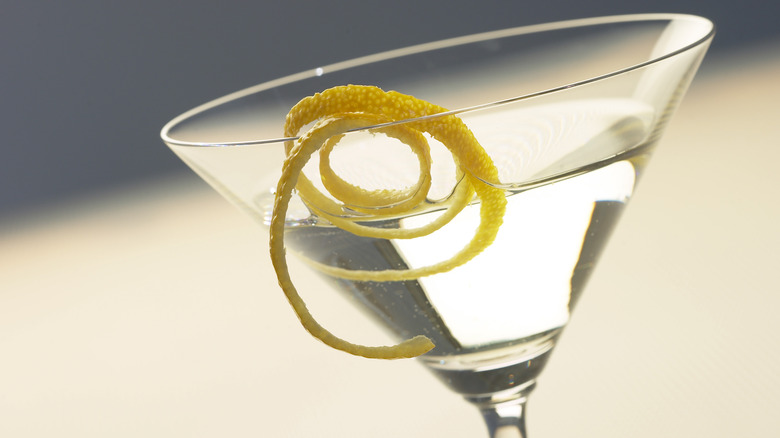Which Came First, A Martini With An Olive Or A Twist?
Some people enjoy a savory dirty martini with an olive, while others like the citrus notes provided by a martini with a twist. These are both seen as classic cocktails, but folks may wonder which of them is the most classic. That is to say, which came first? Some evidence may point to the twist, but the simple fact of the matter is — we're not sure.
To get an idea of why this is such an enigma, you first have to understand that we're still not certain where martinis themselves originated. Since the 1860s, there has been a brand of vermouth named Martini & Rossi, so it's often theorized that the drink is a variation of a Marguerite or another cocktail with that specific vermouth. The name may be even older than that, by some accounts. Late 1800s cocktail recipes that include gin and vermouth sometimes use citrus and olives, but the first ones that could be considered martinis sometimes do not. The oldest recipes currently on record that use the moniker "martini" do tend to mention lemon in some capacity, but not always. The history of these drinks is all so hazy that it's still a complicated question, but you can still get into the semantics to come up with a soft answer.
It all depends on what you consider a martini
The sticking point here is really whether a mid-1800s drink called the Martinez counts as a martini. There's some evidence that the Martinez was called a "martini" by those who drank it, and was named after a Californian city. If the martini is not just named after the vermouth and instead comes from this drink, then that would mean the first Martinez recipe found in a 1884 bartender's book is the most classic one. It uses neither lemon peel nor olives! If you decide it doesn't count as the first martini, you have to look at old Marguerite recipes and when the actual name "martini" was first used.
Recipes for the Marguerite, which mirrors contemporary martinis, may date from 1896. This drink can use both citrus and olives. For example, one of the early 1898 Marguerite recipes suggests placing an olive at the bottom of the glass. The other ingredients are nearly the same as a modern day 50-50 martini. However, that same book has an almost identical recipe listed under the title "martini," and it includes a lemon peel rather than an olive. This could suggest that olives may have actually once indicated a drink was not a martini, but that's uncertain. If that's the case, it didn't last that way for long. A 1904 recipe describes a dry martini cocktail as having a cherry or olive garnish, and is one of the first times the name and an olive inclusion are paired. On the other hand, the oldest actual martini recipe on record from 1888 has the classic martini served with ice and lemon. If you assume that a Martinez and Marguerite are not martinis, then it seems that the twist wins the day.
The lemon twist may have come first
To this day, we don't have a solid answer as to whether or not the martini with a twist is the original variant, but it is possible. The 1800s recipes of its predecessors often came garnished with a cherry or some sweetened syrups, also indicating that perhaps a fruity note would be the first one introduced. Lemon slices or peels do appear before olives, even if we assume the Martinez and Marguerite are martini cocktails, but the very first known versions of both cocktails use neither. With all this in mind, any definitive answer is still just conjecture rather than relying on actual proof.
While we can make some educated guesses, we may never truly know which is the "proper" way to drink one of these cocktails. You might as well just enjoy whichever one you want. Martinis have been beloved by important people for over 100 years, with both Churchill and Ernest Hemingway having a particular way they liked this drink. Both twists and olives still have their merits, depending on whether you like your drinks more salty or more sweet. If you want to get one of the actual oldest versions of a martini, you should probably go with neither.


